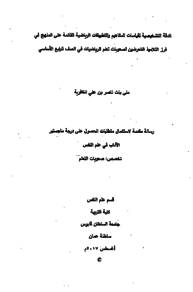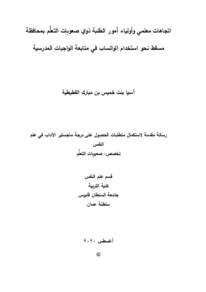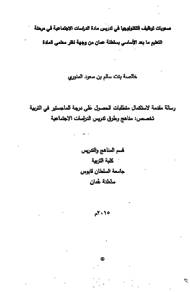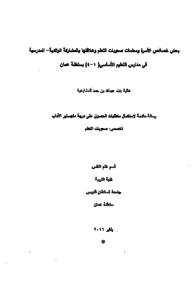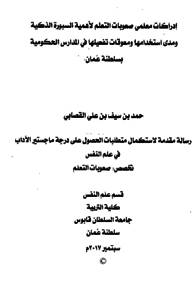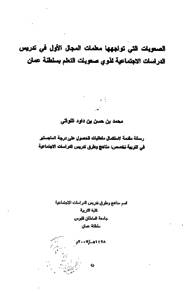Document
الدقة التشخيصية لقياسات المفاهيم والتطبيقات الرياضية القائمة على المنهج في فرز التلاميذ المعرضين لصعوبات تعلم الرياضيات في الصف الرابع الأساسي.
Publisher
جامعة السلطان قابوس
Gregorian
2017
Language
Arabic
English abstract
This study aimed to measure the diagnostic accuracy of mathematical concepts and applications curriculum based measures (MCAP-CBM) in screening for fourth grade students at risk for mathematical learning disabilities. The study also sought to determine the benchmarks for the classification of students in MCAP-CBM, namely frustration, instructional., and mastery levels. To achieve the objectives of the study three alternative and adequate forms of MCAP-CBM were developed for screening and progress monitoring purposes. The measures included all the skills that were likely to be mastered by the end of the school year. The MCAP-CBM consisted of 24 items as described in the traditionally and empirically developed measures in the literature. The study sample included 393 students from both genders enrolled in fourth grade in schools in Muscat. The MCAP-CBM administered three times per the academic year in order to develop benchmarks for the classification levels. The 25th. And 75th. Percentile benchmarks were used to validate the benchmarks for the three classification level: Frustration, instructional,
and mastery. T- test showed that there were statistically significant in frustration level in the favor of the female pupils. The results also showed no differences in the classification levels instructional and mastery) between males and females. The Receiver Operating Characteristic (ROC) Curve was used to examine the diagnostic accuracy of the MCAP-CBM using mathematics achievement scores as the outcome measure. The study presents a number of recommendations: curriculum based measurement can predict the performance of students and therefore it can be an effective element in decision making; it also helps in universal screening; and that the percentile 25th is a reliable benchmark for identifying students at risk for mathematical learning disabilities.
Member of
Resource URL
Arabic abstract
هدفت هذه الدراسة إلى قياس الدقة التشخيصية لقياسات التطبيقات، والمفاهيم الرياضية القائمة على المنهج في فرز التلاميذ المعرضين لصعوبات تعلم الرياضيات في الصف الرابع الأساسي، كما سعت الدراسة إلى تحديد المستويات التصنيفية لتصنيف مستويات التلاميذ في التطبيقات، والمفاهيم الرياضية. ولتحقيق أهداف الدراسة، تم بناء ثلاثة اختبارات متكافئة وفق القياسات القائمة على المنهج في التطبيقات، والمفاهيم الرياضية المستخدمة في الفرز، ومراقبة التقدم، وهي على هيئة قياسات قائمة على أساس المهارات، تتضمن جميع المهارات المتوقع إتقانها في نهاية العام الدراسي، وتحتوي على اربعة وعشرين سؤالا طبقا لمداخل القياسات القائمة على المنهج التقليدية الإمبريقية
المعروفة، وقد تكونت عينة الدراسة من ۳۹۳ تلميذا وتلميذة من تلاميذ الصف الرابع الأساسي بمحافظة مسقط. تم التطبيق ثلاث مرات في العام؛ بهدف الفرز واستخراج المحكات (المستويات التصنيفية)، وأظهر تحليل منحنی ROC الدقة التشخيصية للدرجات الفاصلة لكل من المئيني ۲۰ والمئيني 75، وباستخدام الدرجات الفاصلة تم تحديد المستويات التصنيفية الثلاثة: إتقان، وتعليمي، وإحباط.
أظهر تحليل اختبار "ت " أنه توجد فروق ذات دلالة إحصائية وفقا لمتغير النوع في مستوى الإحباط لصالح الإناث، كما أظهرت النتائج أنه لا توجد فروق في المستويات التصنيفية التعليمي، والإتقان) وفق متغير النوع، وخرجت الدراسة بجملة من التوصيات، أبرزها: أن القياس القائم على المنهج في المفاهيم والتطبيقات الرياضية يتوقع أداء التلاميذ ويكون عنصرا فاعلا في صنع القرارات، ويكون ملائما للفرز الشامل، وأن المئيني ۲۵ يمكن الاعتماد عليه في تحديد التلاميذ المعرضين لصعوبات تعلم الرياضيات.
المعروفة، وقد تكونت عينة الدراسة من ۳۹۳ تلميذا وتلميذة من تلاميذ الصف الرابع الأساسي بمحافظة مسقط. تم التطبيق ثلاث مرات في العام؛ بهدف الفرز واستخراج المحكات (المستويات التصنيفية)، وأظهر تحليل منحنی ROC الدقة التشخيصية للدرجات الفاصلة لكل من المئيني ۲۰ والمئيني 75، وباستخدام الدرجات الفاصلة تم تحديد المستويات التصنيفية الثلاثة: إتقان، وتعليمي، وإحباط.
أظهر تحليل اختبار "ت " أنه توجد فروق ذات دلالة إحصائية وفقا لمتغير النوع في مستوى الإحباط لصالح الإناث، كما أظهرت النتائج أنه لا توجد فروق في المستويات التصنيفية التعليمي، والإتقان) وفق متغير النوع، وخرجت الدراسة بجملة من التوصيات، أبرزها: أن القياس القائم على المنهج في المفاهيم والتطبيقات الرياضية يتوقع أداء التلاميذ ويكون عنصرا فاعلا في صنع القرارات، ويكون ملائما للفرز الشامل، وأن المئيني ۲۵ يمكن الاعتماد عليه في تحديد التلاميذ المعرضين لصعوبات تعلم الرياضيات.
Category
Theses and Dissertations

